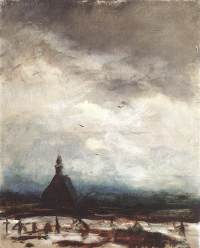
When World War I broke out, Mednyászky wanted to join the army and fight on the front, but he failed to be accepted because of his age. He was, however, accepted, as a war drawer. He accompanied the Austro-Hungarian army to almost all fronts and was even injured once. When an inventory was made in Villach on 13th August 1916, it listed 223 large drawings and water colours, and 421 smaller drawings of the front in the South-West. When he was granted holiday, he created visions unique in universal art. They include demonic close-ups showing deep suffering and tragic defencelessness of masses of people marching in the Carpathian Mountains or the Alps in the background. He portrayed soldiers resting who are utterly exhausted by slaughters and murders.
There is nobody in the picture, their former presence is referred to by crosses in the snow: nature is left to suffer in the storm on its own. The sky which used to be friendly is now covered by grey clouds dominating the colourless and undistinctive landscape. Greyish colours ranging from white and black indicate hopelessness. The healthy proportion of sky and earth is ruined: the gloomy sky characterises the sad reality.